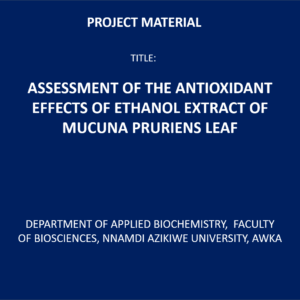No products in the cart.
Anti-Inflammatory Effect Of Aqueous Extract Of Chromoleana Odorata on Malondialdehyde and ESR Levels Of Indomethacin-Induced Ulcer in Wister Albino Rat
₦10,150.00
ANTI-INFLAMMATORY EFFECT OF AQUEOUS EXTRACT OF CHROMOLEANA ODORATA ON MALONDIALDEHYDE AND ESR LEVELS OF INDOMETHACIN-INDUCED ULCER IN WISTER ALBINO RAT
- PROJECT YEAR: 2023
- NUMBER OF PAGES: 48
- FILE TYPE: PDF
- DEGREE: BACHELOR
- DEPARTMENT: DEPARTMENT OF APPLIED BIOCHEMISTRY, FACULTY OF BIOSCIENCES, NNAMDI AZIKIWE UNIVERSITY, AWKA
ABSTRACT
From time immemorial plants have been used to treat a variety of diseases traditionally, one of these herbs include the Chromolaena Odorata, a perennial crop which has been known for its antioxidants, anti-malarial, anti-inflammatory, as well as its anti-ulcerative properties. These properties are as a result of the phytochemical properties of the crop. The study investigated the Malondialdehyde and Erythrocyte Sedimentation Rate effect of the aqueous extract of Chromolaena odorata on groups of wister albino rats. The rats were divided into seven (7) groups of ten (10) rats each Group A (normal control) free of ulcer and received zero treatment, Group B (standard positive control) was given 0.4mg kg of Omeprazole only. Group C (Negative control) received no treatment after ulcer induction. Group D. E and F which were the treated groups received 200mg/kg, 400mg/kg and 600mg/kg body weight of the extract respectively. Group G(Omeprazole & C. odorata) received treatment of 400mg C. Odorata dose and Omeprazole combined. The administration of the extract was done orally for a total period of 14 days. The 200mg, 400mg, and Omeprazole + treatments might have a beneficial effect on reducing inflammation (as indicated by decreased ESR levels) and the reduction in MDA levels observed in the 200 mg group dosage may be associated with an improvement in ulcer condition.After
14 days of treatment, Erythrocyte sedimentation rate (ESR) levels showed significant (p<0.05) increase in the rats administered 600 mg/kg C. Odorata aqueous extract when compared to the normal control group. After week 2 (14 days) The result showed no significant in the Malonaldehyde (MDA) levels of rats administered with C. odorata aqueous extract when compared to the normal group






